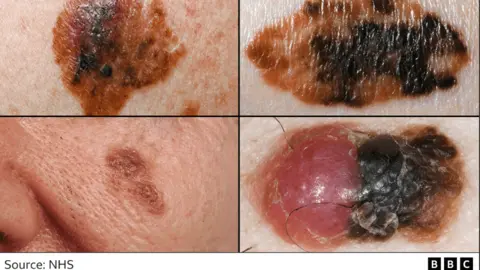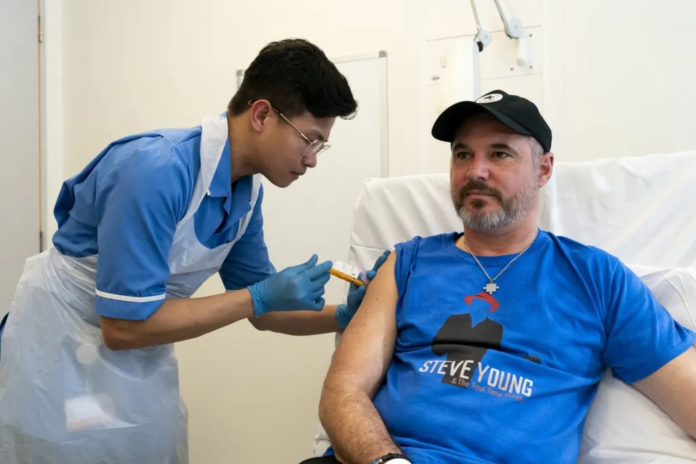An important trial of the world’s first “personalised” mRNA vaccine against the deadliest form of skin cancer – melanoma – is now under way in the UK.
Steve Young, 52, from Stevenage, Herts, who had a melanoma growth cut out of his scalp last August, is one of the first patients to try the shot.
It is designed to help his immune system recognise and wipe out any remaining cancerous cells.
And hopefully, that means his cancer will not return.
The jab, mRNA-4157 (V940), uses the same technology as current Covid vaccines and is being tested in final-stage Phase III trials.
University College London Hospitals (UCLH) doctors are giving it alongside another drug, pembrolizumab or Keytruda, that also helps the immune system kill cancer cells.
Genetic signature
The combined treatment, made by Moderna and Merck Sharp and Dohme (MSD), is not yet available routinely on the NHS, outside of clinical trials.
Experts in some other countries, including Australia, are also trying it on patients, to gather more evidence and see whether it should be rolled out more widely.
The vaccine is personalised – meaning the make-up of it is changed to suit the individual patient.
It is created to match the unique genetic signature of the patient’s own tumour and works by instructing the body to make proteins or antibodies that attack markers or antigens found only on those cancer cells.
‘Custom built’
UCLH investigator Dr Heather Shaw said the jab had the potential to cure people with melanoma and was being tested on other cancers – lung, bladder and kidney tumours.
“This is one of the most exciting things we’ve seen in a really long time,” she said.
“It is absolutely custom built for the patient – you couldn’t give this to the next patient in the line because you wouldn’t expect it to work.
“It’s truly personalised.
“These things are hugely technical and finely generated for the patient.”
‘Really excited’
The UK part of the international trial aims to recruit at least 60-70 patients across eight centres, including in London, Manchester, Edinburgh and Leeds.
The patients on trial must have had their high-risk melanoma surgically removed in the last 12 weeks to ensure the best result. Some of them will get a dummy or placebo shot rather than the vaccine. None of them know which they are receiving though.
Mr Young is having his treatment in London.
Speaking to BBC Radio 4 Today Programme, he said: “[The trial] gave me a chance to feel like I was actually doing something to fight a potential unseen enemy.
“Scans showed I was radiologically clear, obviously there is still the chance I had cancer cells floating around undetected.
“So rather than just sit there and wait and hope it was never going to come back, I actually had this chance to get involved in putting on some boxing gloves and squaring up to it.”
Melanoma symptoms to look for
The musician had a lump on his scalp for many years before realising the growth was cancer. He said being diagnosed was a “massive shock”.
“I literally spent two weeks just thinking ‘this is it’,” he said.
“My dad died of emphysema when he was 57 and I actually thought ‘I’m going to die younger than my dad’.”
Common signs of melanoma to check for include:
- a new abnormal mole
- an existing mole that seems to be growing or changing
- a change to a previous patch of normal skin
What does melanoma look like?

Change in appearance of a mole, as in these four pictures, can be a sign of melanoma
The ABCDE checklist can help identify if a mole is abnormal:
- A – asymmetrical (does the mole have an uneven shape?)
- B – border (are the edges blurry or jagged?)
- C – colour (is it an uneven colour with different shades and tones?)
- D – diameter (is the mole bigger than your other ones?)
- E – evolving (is it changing, such as starting to itch, bleed or become crusty?)
These changes won’t always be cancer, but it is important to get checked.
The earlier a melanoma is picked up, the easier it is to treat and the more likely treatment is to be successful.
Phase II trial data, published in December, found that people with serious high-risk melanomas who received the jab alongside the immunotherapy Keytruda were almost half (49%) as likely to die or have their cancer come back after three years than those who were given only the drug.
Dr Shaw said there was real hope the therapy could be a “gamechanger”, particularly as it appeared to have “relatively tolerable side effects”.
These include tiredness and a sore arm when the jab was given, she said, adding that for the majority of patients it appeared no worse than having a flu or Covid vaccine.

